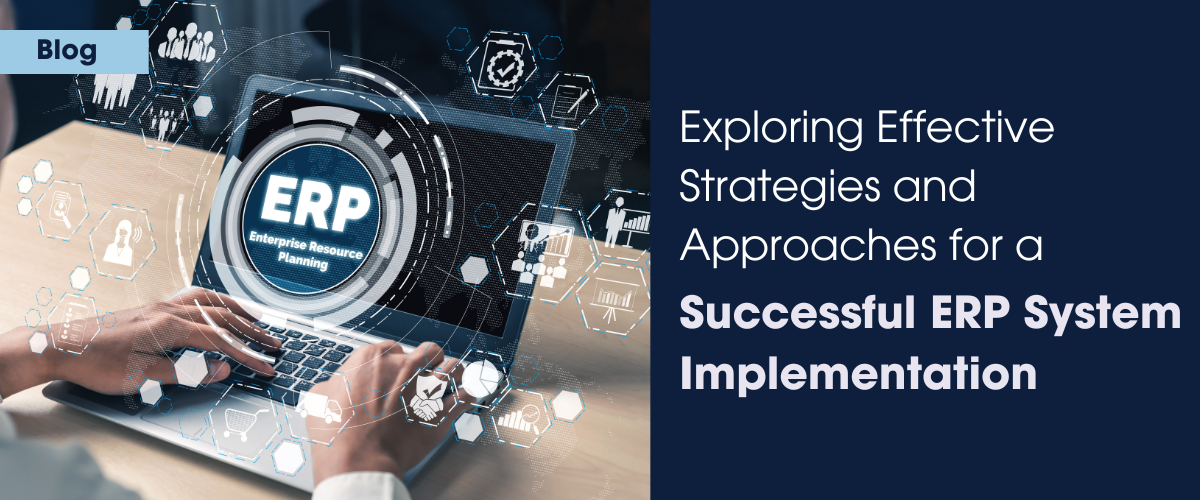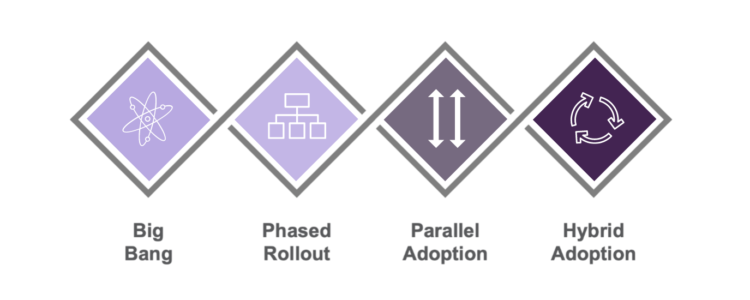Exploring Effective Strategies and Approaches for a Successful ERP System Implementation
- Prabal Laad

An ERP system is a comprehensive software suite that encompasses various aspects of your organisation, including accounting, manufacturing, inventory, distribution, and sales. Due to its wide-reaching impact on multiple facets of your business, meticulous planning of the rollout becomes crucial. This entails a series of stages, starting from initial analysis and design, progressing through deployment, and continuing with ongoing support and maintenance.
Implementing a new ERP system is a significant endeavour that requires careful consideration. Numerous case studies across various industries demonstrate that selecting the appropriate implementation strategy plays a pivotal role in maximising the likelihood of a successful transition.
Many ERP implementations pose challenges for organisations associated with complex integrations with existing legacy systems. Besides, the customisation of an ERP system requires special capabilities that can help match diverse processes, workflows, and industry-specific needs.
Within this article, we will offer a range of potential strategies that can create mutually advantageous outcomes, unlocking a pathway abundant with fresh opportunities for organisations.
Evaluating the Top 4 ERP Implementation Strategies
When it comes to the critical deployment stage, there are several possible strategies, offering different potential advantages and risks. While there are a few proven strategies for transitioning to new ERP systems, each with advantages and disadvantages, successful implementations always depend on the stakeholders working together with a shared goal and vision of business success.
These are the four most common Implementation Strategies:

1. Big Bang
The advantage of this implementation method is the faster realisation of the ERP’s benefits for the business, such as higher productivity, better insights, and lower operating costs. However, in this method, once you’ve rolled out the ERP system it’s hard to go back, so it’s critical to get things right. Any error or glitch—even a relatively minor one—can impact employees, business partners, and customers. There may also be a temporary productivity drop as employees get used to the new system.

Pros and cons of the big bang approach:
- The implementation timeline is shorter
- Cost can be much lower than any other implementation approach
- All training is completed for users before the initial roll-out
- ERP system roll-out happens on a planned go-live date
- Details may be overlooked in the rush to change
- Employees are constrained to learn the new system before the designated implementation date
- Fall-back to a legacy system may be more difficult than originally perceived
- A failure in one area of the system could affect others
- Pronounced dip in performance after the implementation
2. Phased Rollout
Under a phased rollout approach, the deployment of features, tools, and components is done over an extended period, which may cover weeks or months. This highly measured approach can be less risky than the big-bang strategy. It also enables the company to focus first on “quick wins”—the functions that deliver the most immediate benefits—and to apply learnings from the initial deployment phases to improve the process for subsequent phases.
But there are drawbacks as it takes longer to reap the complete benefits of the new ERP system, and your company will need to support, and pay for, two systems at the same time.

Pros and cons of the phased roll-out approach:
- Lessons learned can be used for a successive phased roll-out
- Ample time for adjustments to the planned deployment
- More time for users to adapt to the new system
- Project team members develop implementation skills for subsequent roll-out phases
- A step-by-step approach to implementation
- Less risk
- Continuous changes over a longer period
- Fallback to legacy becomes more difficult if required
- Temporary solutions to legacy issues are created to support the phased roll-out
- Employee change fatigue
- Longer implementation timeline
- Delayed integration of the whole business process
- Potential rise in integration complexities
- A larger number of technical resources to create an interface program
3. Parallel Adoption
With this strategy, the organisation keeps using its legacy systems in parallel with the new ERP for a specific length of time. This is generally considered the least risky approach because it’s possible to revert to the legacy system if you run into problems. Because of its low-risk approach, some organisations use this strategy for critical functions that absolutely must always continue operating.
This approach can also make it easier for some users to gradually adjust to the new system. However, parallel adoption can be an expensive approach because it requires more staff time and resources to keep two systems running at the same time. And parallel adoption can create its own risks: Entering data twice, into two different systems, doubles the chance of errors.
Still, this might be the best bet for companies using a two-tier ERP architecture, a setup often found in firms that have expanded, whether organically or through mergers and acquisitions.

Pros and cons of the parallel roll-out approach:
- Minimises data integrity and migration issues
- Risk is moderate
- Increases users’ confidence to use the new system
- Double keying of data is very labour intensive
- Greater risk for mistakes
- Increase potential for higher cost
4. Hybrid
As the name implies, this approach combines elements of the strategies above. For example, an organisation might switch on core ERP modules using a big-bang strategy, then roll out other modules in phases to specific locations or departments.

Pros and cons of the hybrid roll-out approach:
- Greater controls of the ERP implementation
- Moderate risk
- Costly to implement
- Time intensive
- The full integration picture is compromised
Unlock Success with InspireXT: Your Trusted Partner for Seamless ERP System Adoption and Maximised Value
As your trusted partner, we at InspireXT are thrilled to collaborate with you and guide you toward the successful adoption of any ERP system. Our approach to ERP implementation is centered around ensuring your business gains the utmost value from your investment, employing a comprehensive and inclusive methodology. By prioritising tangible present and near-future requirements, our implementation approach is meticulously tailored to drive the anticipated business outcomes, allowing you to maximise the benefits of the solutions we offer.
Request for services
Find out more about how we can help your organisation navigate its next. Let us know your areas of interest so that we can serve you better.




